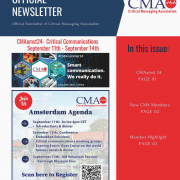Ensuring reliable availability during times of crisis: critical infrastructures require “double support”
Berlin, 20 March 2020: The world is almost shutting down. Due to the rapid spread of the Covid 19, countries are declaring a state of emergency. In practice, this means focusing on the essentials, for example safeguarding critical infrastructures. However, the sudden massive burden on existing IT and TC systems due to millions of mobile or home office activities is creating an unprecedented situation in the digital communications sector too. So it is all the more important that emergency crews, among others, are able to rely on a second infrastructure.
Millions of employees, students and school pupils are getting a vague impression at the moment of what “readiness” means. The short-notice relocation of management or communication departments to mobile or home offices, the shifting of face-to-face appointments, meetings and conferences to the Internet or simply an increase in the number of digital telephone calls, correspondence or training are subjecting the existing ITC infrastructure to a massive stress test. The infrastructure does not always pass this test, and the number of significant delays or outages is increasing.
A real standby service for emergency crews in critical infrastructures depends on stable communications systems in order to be reliably reachable and therefore available promptly in the event of emergency. From emergency assistants to members of the company fire brigade, critical infrastructure team members rely on dependable alarm and emergency communication systems all across Europe and USA. This is why a second infrastructure – a second support – is so important alongside digital and mobile radio systems: it must be possible to alert rescue and security teams reliably. The second infrastructure needs to be available at all times, not just when the primary solution fails (e.g. land line telephones, mobile phones, TETRA). This is the only way that control and deployment centres and crisis teams will be able to reach emergency crews reliably at all times.
Europe’s large security radio networks operate from Berlin, Suresnes near Paris, from Samstagern near Zurich, from Stockholm.
All are active members of Critical Messaging Association using devices from other members of the Association or providing Multichannel Services by itself. Combining Narrowband Point to Multipoint (including Paging) Services with Cellular ones (like GPRS, IoT, 4G, 5G and Tetra).
“We guarantee a high-availability, redundant infrastructure”, says Carsten Hofman, Managing Director of e*Message. Similar is heard from Madelene Persson, Board Member in Generic Mobile Sweden, Harald Pfurtscheller from Swissphone’s Telepage or Vincent Delpont with his french e*Message Headquarter 200m from Seine River.
They all are providing countrywide wireless services for First Responders and Firefighters as well as for Industry 4.0 and Energy Providers.
Dietmar Gollnick (d.gollnick@emessage.de)





